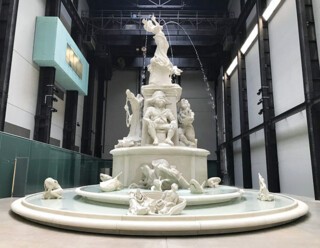Kara Walker’s Fons Americanus, currently on display in Tate Modern’s Turbine Hall (until 5 April), is a towering monument – more than forty feet tall – based loosely on Thomas Brock’s Victoria Memorial of 1911, which stands outside Buckingham Palace. Walker, an African-American artist who was born in California and lives in New York, first saw the Victoria Memorial from the window of a taxi on her way to the airport: a wedding-cake configuration of forms arranged on a quatrefoil platform, with a winged Victory in gilded bronze at its apex. Just below sit four pale marble figures, among them a portrait of Victoria herself. Closer to street level are seated allegories of Naval Power, Military Power, Science and Art, as well as statues of Peace, Progress, Manufacture and Agriculture. The challenge of the project, one of Brock’s contemporaries wrote, was to make its various parts ‘click together like a puzzle’. Seen from a moving car, the memorial may have appeared to possess the formal unity that Brock sought but didn’t quite achieve.
Walker couldn’t have seen at first glance, however, what for her would become the memorial’s most significant feature: water. The base of Brock’s memorial consists of a walled platform containing two fountains, with two corresponding basins into which water cascades. As Brock saw it, this represented ‘the maritime greatness of the empire’; Walker took the idea and ran with it. Mimicking the basic composition of the memorial (circular base, quatrefoil and pylon), she turned the two basins into a complete ring of water, adding an extra pool on the second tier. She doesn’t depart from Brock’s symbolism – the pools still represent the pelagic zones that link the Anglophone world to everywhere else – but Fons Americanus specifically refers to journeys to and from Africa, and the enmeshed histories of slavery, capitalism and colonialism.
The piece features an array of sculpted figures, each with a distinctive form and an articulate shape and surface. Instead of Brock’s Victory, Walker crowns her monument with a Yoruba goddess. Two jets of water spurt from her breasts to the drowning men in the bottom pool. Walker’s sculptures present a challenge to Brock’s slickness: they are made from baked cork, softwood, plywood and steel, all clad in jesmonite, a coarse material invented in 1984 as an alternative to fibreglass, and deliberately left rough (visitors are allowed to touch the work but its abrasive texture is evident at sight).
Brock’s figures, by contrast, are products of a sculptural practice obsessed with smoothness. Although he came to be seen as an artist who ventured beyond the effete prettiness of much 19th-century public sculpture, the Victoria Memorial remains loyal to a classicism at odds with roughness. A hundred years earlier, Antonio Canova developed a technique that made the surfaces of his marble figures appear impossibly smooth – more like that of enamel or ivory. The reaction against Canova and his school began long before the Victoria Memorial was commissioned, but he remained a dominant influence, at least for sculptors undertaking public works. When light hits Brock’s figures of Motherhood, Truth and Justice, they dissolve into swathes of skin and drapery.
Smoothness goes hand in hand with a certain view of history: a sealed record, a fixed account. Fons Americanus rejects this tradition in favour of another. Walker’s figures resemble bozzetti, the small clay sketches that 19th-century sculptors executed in preparation for larger works. For Canova in particular, the bozzetto presented an opportunity to work more impulsively (the ones he left behind later became significant for abstract expressionists). The modelling of Walker’s figures has a similar spontaneity: they are, in fact, replicas of her own bozzetti, with seemingly few major changes made during the enlargement process.
Walker’s originals were digitally scanned before being reproduced with the help of a robotic arm; despite the precision offered by this technology, she has used it to create a work with intentionally few fine details. Even the largest, most imposing figures in Fons Americanus – the caricature of Victoria in the guise of an African woman, for example – appear to have been carved with a fettling knife or the teeth of a rasp, while others are shaped by indentations that look like huge fingerprints. This is the historical record ripped open. Towards the rear of the bottom pool, away from the gallery entrance, a shrunken figure – the father of Emmett Till – cradles his son’s corpse. The two are fused together in a clot of heads and limbs, with Till’s distended abdomen at the centre, riven with bullet holes. It’s not clear whether they are sinking or emerging from the water. The most refined elements of the piece are the sharks that appear at intervals in the upper pool. They play a double role, representing Walker’s disruptive approach to surfaces and ‘our catastrophic sea crossings’, as she puts it in the catalogue.
In the lower part of the first pool, a dreadlocked figure crouches in the water. Intentionally androgynous, this is a Maroon rebel, one of the people of African descent who evaded chattel slavery in the Americas. But you wouldn’t know it from looking at the work. (Brock’s icons, on the other hand, carry accessories to help us identify them: Agriculture, for instance, has a sickle and sheaf of corn.) The crudeness of Walker’s sculptures renders the majority of her figures unintelligible: they are resisting what Fanon called ‘crushing objecthood’. We need help – provided in the catalogue but not in the wall texts – to discover who they are.
Walker has frequently tried to make artistic forms work against their usual logic. Her best-known pieces, silhouettes illustrating racist stereotypes and scenes of violence, expose ‘the inadequacy of any representational system to express the horrific brutality of slavery’, according to the art historian Rebecca Peabody. If Walker’s silhouettes are an attempt to visualise this inadequacy, what would it mean for an artwork to address it? Should it even try?
These questions have troubled artists since abolition. When Turner’s Slavers Throwing Overboard the Dead and Dying (now known as The Slave Ship) was shown in London in 1840, one critic compared it unfavourably to François-Auguste Biard’s The Slave Trade, in the same exhibition. Biard’s picture was praised for displaying ‘much at which humanity suffers, much at which the blood boils’, while containing ‘nothing to excite disgust’. Turner’s painting was all too likely to excite disgust, both for its depiction of the dying slaves, torn apart in the water by fish and sharks, and for its style: ‘masses of red, white and yellow, dashed upon the canvas at hazard’.
Turner’s slave ship makes an appearance in the lower pool of Fons Americanus, reimagined with billowing sails and a hull scored with chisel marks, in tribute to his efforts on behalf of the Anti-Slavery Society. Walker’s adaptation of Brock, on the other hand, is deliberate profanation. The comments beneath the Daily Mail’s review show the reverence conferred on such monuments: ‘The new one looks very poorly made. Cheap stone and no gold gilding. I do hope the council keeps the original [Brock’s work] as it is more inspirational.’ And: ‘History is history. Don’t destroy the relics – please just let them be reminders to learn from past experience and do things better in the future.’
The second anxiety is misplaced. Walker doesn’t seek to destroy historic monuments but to rework them. ‘I’m fascinated by the grandeur, the pompousness, the overmuch.’ A similar attitude can be seen in the work of the Scottish-Guyanese artist Hew Locke, whose photographs of historic statues and busts are manipulated to show the subjects adorned with brightly coloured ornaments from postcolonial cultures, and in the paintings of Shorsh Saleh, who depicts the contemporary migrant experience in traditional Turkish miniatures.
Walker’s Shell Grotto, a second, smaller sculpture on show in the Turbine Hall, takes one of the most familiar art-historical motifs – the scallop shell – and uses it to show a modern black figure emerging from the sea (which Walker describes as ‘amniotic’). A young boy peers out from an aperture at the base of the shell, his expression both startled and enraptured. Botticelli’s Venus is an obvious antecedent, but so too is the print entitled The Voyage of the Sable Venus from Angola to the West Indies (1801), which shows an enslaved African woman, a manacle around her neck, rising from the ocean surrounded by sea gods and putti – one of a number of contemporary images that aestheticised the slave trade. Walker repurposes these artistic tropes to pay tribute to the Africans who, in 1726, were tortured and drowned on Bunce Island, then the British port in Sierra Leone, after they refused to board a slave ship. Perhaps the figure represents their collective spirit rising from the depths, or one of their orphans. In an essay written two hundred years after the rebellion, W.E.B. Du Bois lamented that somewhere ‘in New York tonight a black woman [is] moulding clay by herself in a little bare room, because there is not a single school of sculpture in New York where she is welcome.’ This is work in progress.
Send Letters To:
The Editor
London Review of Books,
28 Little Russell Street
London, WC1A 2HN
letters@lrb.co.uk
Please include name, address, and a telephone number.


